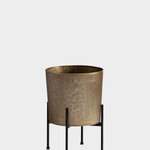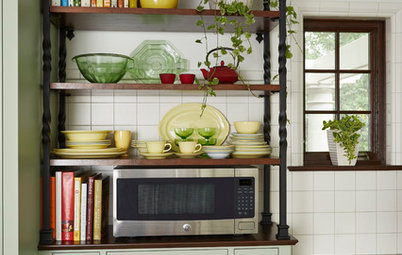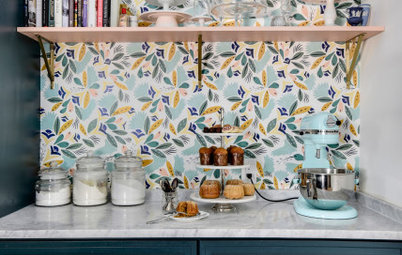Kitchen Design
Why You Should Include a Mirror in Your Kitchen, and How to Do It
Reflective surfaces can make your cooking space look bigger and brighter
Incorporating a carefully chosen mirror into your kitchen injects a touch of glamour and brings other benefits. The reflective surface bounces light back across a room, boosting brightness and adding a sense of depth. It’s also a simple but highly effective way to make your space look bigger. Depending on what type of mirror you go for, it can be a relatively inexpensive way to improve your cooking space. Browse these imaginative ways to add mirrored glass to your kitchen.
Install one behind the sink. As mentioned, mirrors are great for reflecting light, which will make a kitchen feel more spacious, open and bright. This means they’re especially effective in small or dark kitchens, where they can transform an otherwise dingy space into a comfortable place for cooking, working and socializing. Here, the mirror reflects the yard back into the room, which really helps to open it up.
Get the right finish. Getting the right type of mirror is key. For a traditional kitchen or one in a period home, consider an antiqued design, which has a mottled appearance and creates a lovely soft, vintage look. (It can also work well in a modern kitchen.) If you want to go super contemporary, a tinted mirror is a good option. Tinted designs come in a choice of colors, including smoked black glass and bronze, as shown here.
A mirrored glass backsplash must be made from tempered glass, otherwise exposure to heat or an accidental knock could cause it to crack or break. And mirrored glass can be shaped, drilled or cut to include socket cutouts or to work around awkward corners. Mirrored glass also can be fitted in sheets up to 10 feet long, which for most kitchens means you won’t have any visible joins.
While it looks beautiful, the major downside of a mirrored glass backsplash is that its intensive manufacturing process is reflected in the cost, making it more expensive than most other backsplashes. But consider how dramatically it could affect the feel of your kitchen and the sense of space. You might decide it’s worth the investment.
A mirrored glass backsplash must be made from tempered glass, otherwise exposure to heat or an accidental knock could cause it to crack or break. And mirrored glass can be shaped, drilled or cut to include socket cutouts or to work around awkward corners. Mirrored glass also can be fitted in sheets up to 10 feet long, which for most kitchens means you won’t have any visible joins.
While it looks beautiful, the major downside of a mirrored glass backsplash is that its intensive manufacturing process is reflected in the cost, making it more expensive than most other backsplashes. But consider how dramatically it could affect the feel of your kitchen and the sense of space. You might decide it’s worth the investment.
Panel cabinet doors. Mirrored doors work beautifully on wall cabinets because the eye-level position offers maximum light reflection, giving the impression of a brighter, larger, more open space.
Mirrors are also a good alternative to plain glass if you struggle to keep your cabinets tidy inside.
If you’re worried about keeping the shiny surface clean, a finish such as antiqued mirrored glass, as seen here, will make fingerprints or smudges less noticeable, in addition to adding character.
Mirrors are also a good alternative to plain glass if you struggle to keep your cabinets tidy inside.
If you’re worried about keeping the shiny surface clean, a finish such as antiqued mirrored glass, as seen here, will make fingerprints or smudges less noticeable, in addition to adding character.
Another option for cabinet doors is colored glass. This can be a good alternative to gloss cabinet doors and provides a surface with even deeper reflective properties, as shown here.
While glass doors are more expensive than other gloss options, you can easily mix and match them with other finishes. These blackberry-colored cabinet fronts have been combined with white gloss lacquer cabinets to create a stylish two-tone scheme.
While glass doors are more expensive than other gloss options, you can easily mix and match them with other finishes. These blackberry-colored cabinet fronts have been combined with white gloss lacquer cabinets to create a stylish two-tone scheme.
Choose reflective pendants. If you really want to make a statement, consider having a mirrored kitchen ceiling. This isn’t a look that will appeal to everyone, but a softer alternative can be achieved using stylish mirrored light fixtures and fittings. Oversized lights, such as these classic copper pendants, look fantastic above an island or dining table, grabbing attention and creating bright and interesting reflections. Similarly, fittings with mirrored details or chandelier crystals will also reflect the light and make soft patterns across your kitchen walls, creating instant ambience in the evenings.
Use reflective tiles. Another way to make a decorative statement is by using mirrored tiles, but make sure they’re not competing with any other kitchen feature, as these tiles are designed to keep the limelight fully on themselves.
These subway tiles create a striking feature in a small corner, adding a big shot of glamour and boosting light, without the trompe l’oeil effect of sheet mirror. Mirrored tiles come in all sorts of tints and shapes, from hexagons to mosaics, and may be a more affordable option than getting sheet glass cut to size. Be sure to check that your tiles are suitable for the position you have in mind — cooktop backsplash tiles will need to be heat-resistant.
These subway tiles create a striking feature in a small corner, adding a big shot of glamour and boosting light, without the trompe l’oeil effect of sheet mirror. Mirrored tiles come in all sorts of tints and shapes, from hexagons to mosaics, and may be a more affordable option than getting sheet glass cut to size. Be sure to check that your tiles are suitable for the position you have in mind — cooktop backsplash tiles will need to be heat-resistant.
Create an illusion with a panel. A mirrored panel is typically bought cut to size, so it has the potential to be installed in a number of areas in the kitchen, whether over a door, on the fronts of cabinets or, as seen here, horizontally fixed across the width of an island. Here, the panel creates the illusion that the floor extends beyond the depth of the island. This clever positioning means the kitchen seems far more expansive than it is.
Take it to the top. Fill an entire wall with cut-to-fit mirror, and the optical illusion becomes a center-stage feature. It works especially well in this smaller kitchen, making the space seem larger.
Follow the traditional route. You don’t need to opt for an expensive reflective backsplash or custom-cut length of mirror to get the benefits of this material in your kitchen. A simple wall-hung or free-standing mirror can do just as much to brighten your room and enhance the feeling of space, and potentially at a lower cost.
Aside from being decorative, a mirror with a stylish or attention-grabbing frame is also a great way to inject your own sense of style into your kitchen and personalize the look.
Aside from being decorative, a mirror with a stylish or attention-grabbing frame is also a great way to inject your own sense of style into your kitchen and personalize the look.
Disguise features you want to hide. Another smart use of mirrors is to disguise a kitchen element or structure that doesn’t appeal to you.
Structural pillars are a good example of this; these support posts are often present in extended kitchens since they can expensive to remove, but they’re often bulky and prominent. In this kitchen, the pillar has been clad in mirrors, which effectively makes it vanish since all you see are the reflections, not the structure itself. And while cleverly disguising the pillar, the mirrors also turn it into a contemporary feature.
Structural pillars are a good example of this; these support posts are often present in extended kitchens since they can expensive to remove, but they’re often bulky and prominent. In this kitchen, the pillar has been clad in mirrors, which effectively makes it vanish since all you see are the reflections, not the structure itself. And while cleverly disguising the pillar, the mirrors also turn it into a contemporary feature.
This trick can be used to disguise other features too. Here, the large overhead range hood appears far less intrusive because of its reflective, mirrored disguise.
Look in it. When planning what type of mirror to go for and where to put it, particularly if you’re focused on maximizing its light-reflective qualities, it can be easy to forget the obvious: that a mirror will be looked in.
The last thing you want is to spend time, money and effort planning your layout, only to spoil it with a reflected view of a trash can, dirty sink, laundry room or garden shed. Take a look in the mirror and make sure that whatever is reflected is a view that will enhance your space, not clutter it up.
Share: Have you used mirrors in your kitchen successfully? Tell us what you did in the Comments below.
Browse more kitchen guides
The last thing you want is to spend time, money and effort planning your layout, only to spoil it with a reflected view of a trash can, dirty sink, laundry room or garden shed. Take a look in the mirror and make sure that whatever is reflected is a view that will enhance your space, not clutter it up.
Share: Have you used mirrors in your kitchen successfully? Tell us what you did in the Comments below.
Browse more kitchen guides





























This mirrored backsplash reflects the yard, creating the illusion of more outdoor space, as well as visually doubling the presence of the feature brick wall. This light- and space-boosting effect is heightened by combining the mirror with the glass ceiling and large windows.